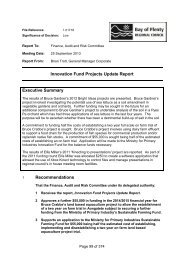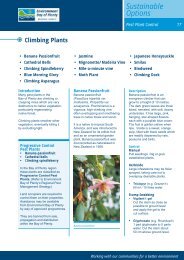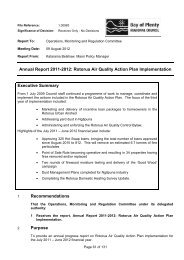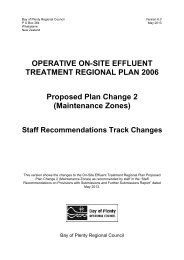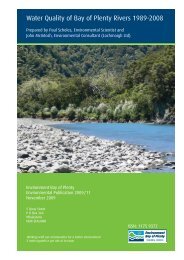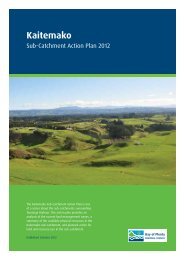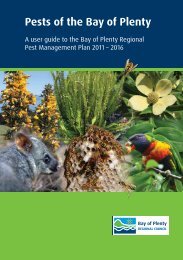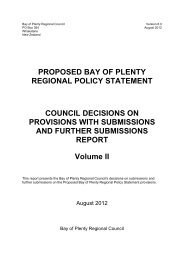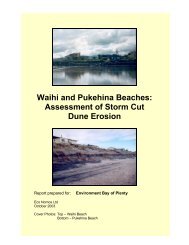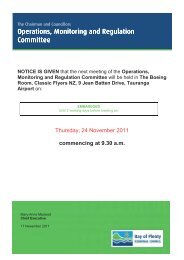Odour Threshold Investigation 2012 - Bay of Plenty Regional Council
Odour Threshold Investigation 2012 - Bay of Plenty Regional Council
Odour Threshold Investigation 2012 - Bay of Plenty Regional Council
You also want an ePaper? Increase the reach of your titles
YUMPU automatically turns print PDFs into web optimized ePapers that Google loves.
Part 5: H 2 S threshold information<br />
<strong>Odour</strong> threshold literature for a particular chemical can provide a wide range <strong>of</strong> threshold<br />
values and, as highlighted within this section, this is certainly the case for H 2 S. Often the<br />
disparity stems, in part, from inter-individual differences in sensitivities to odours, and in part,<br />
from methodological differences 58,59 . Warner 60 has also stated that the widely varying odour<br />
thresholds for H 2 S, some three orders <strong>of</strong> magnitude, are generally ascribed to olfactory<br />
desensitisation, which is a characteristic <strong>of</strong> the gas.<br />
The Good Practice Guide for Assessing and Managing <strong>Odour</strong> in New Zealand 61 states that<br />
published odour threshold data should be used with caution because many different methods<br />
have been used and there is a wide variation reported in the literature, <strong>of</strong>ten by four orders <strong>of</strong><br />
magnitude. As an example, when using dilution dynamic olfactometry methods the odour<br />
threshold is usually taken as the value at which 50 percent <strong>of</strong> the panel are able to detect or<br />
recognise the odour, but some historical data are based on a range <strong>of</strong> different percentages.<br />
Most odour threshold reference data appear to have been developed before dilution dynamic<br />
olfactometry was standardised, so the data may not be directly applicable to assessments<br />
where odour guidelines have been developed based on the standard olfactometry<br />
techniques.<br />
Both detection and certainty, or recognition, odour thresholds for compounds are reported in<br />
the literature. The detection threshold is the lowest concentration <strong>of</strong> a compound that can<br />
just be detected by a certain percentage <strong>of</strong> the population, while the certainty or recognition<br />
threshold is the lowest concentration <strong>of</strong> a compound that can be recognised with certainty as<br />
having a characteristic odour quality. In general, recognition thresholds are approximately<br />
three to five times the detection threshold. When using odour threshold data it is important to<br />
be clear about which type <strong>of</strong> threshold is being reported.<br />
This section lists references for H 2 S threshold data. The majority <strong>of</strong> the information is from<br />
international publications, while the information from local sources relates mainly to the use<br />
<strong>of</strong> threshold data in establishing air quality guidelines.<br />
5.1 International information<br />
Van Gemert 62 provides a compilation <strong>of</strong> published odour threshold data for a wide<br />
range <strong>of</strong> chemical substances. The data for H 2 S is summarised in Figure 5.1, and<br />
covers studies from as far back as 1848. The data are given chronologically for<br />
each compound with the original data source identified, but no attempt is made by<br />
the author (van Gemert) to critically evaluate the data. Van Gemert’s publication is<br />
an update <strong>of</strong> similar previous compilations, such as Devos et al 63 . In addition to van<br />
Gemert’s data, data points (shown in red) have been added as a result <strong>of</strong> a<br />
literature search undertaken during the production <strong>of</strong> this report.<br />
58 van Harreveld, A.P., Heeres, P. & Harssema, H., 1999, A Review <strong>of</strong> 20 Years <strong>of</strong> Standardization <strong>of</strong><br />
<strong>Odour</strong> Concentration Measurement by Dynamic Olfactometry in Europe, J. Air & Waste Manage.<br />
Assoc., 49:705-715.<br />
59 Ramsdale, S.L. and Baillie, C.P, 1996, Inter laboratory Test Program: <strong>Odour</strong> Detection <strong>Threshold</strong> for<br />
Hydrogen Sulphide, Journal <strong>of</strong> the Clean Air Society <strong>of</strong> Australia and New Zealand, Vol. 30 No. 1, 36-<br />
37.<br />
60 Warner, P., 1976, Analysis <strong>of</strong> Air Pollutants, Environmental Science and Technology Series, John Wiley<br />
& Sons Inc, ISBN 9780471921073.<br />
61 Ministry for the Environment, 2003, Good Practice Guide for Assessing and Managing <strong>Odour</strong> in<br />
New Zealand, Air Quality Report 36, ISBN: 0-478-24090-2, ME: 473, Wellington, New Zealand.<br />
62 van Gemert LJ, 2011. Compilations <strong>of</strong> <strong>Odour</strong> <strong>Threshold</strong> Values in Air and Water. ISBN/EAN: 978-90-<br />
810894-0-1.<br />
63 Devos, M., Patte, F., Rouault, J., Laffort, P. van Gemert, L., 1990, Standardized Human Olfactory<br />
<strong>Threshold</strong>s, IRL Press at Oxford University Press.<br />
Environmental Publication <strong>2012</strong>/06–A review <strong>of</strong> odour properties <strong>of</strong> H 2 S <strong>Odour</strong> <strong>Threshold</strong> <strong>Investigation</strong> <strong>2012</strong> 21



